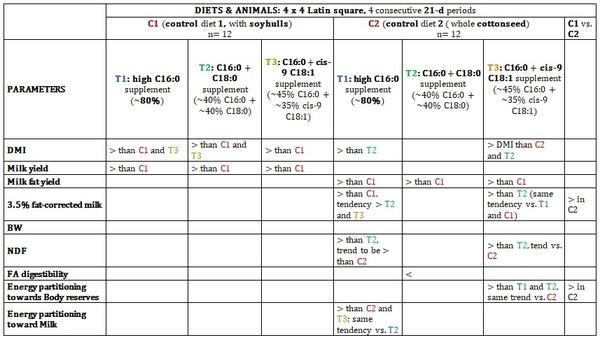Are we wise enough to recommend Fatty Acids Ratios in dairy cows diets?
Published: November 22, 2018
By: Alfredo J. Escribano, DVM, PhD / NUTRION Internacional, www.nutrion.es.
Fats are a key pillar of dairy cows’ nutrition, especially during transition. Supplemental fats are used in most commercial dairies (except those following the New Zealand system or similar ones), and virtually no one doubts its efficacy.
However, to talk about fats is already quite a vague concept for scientists and nutritionists; they need more precision. In this sense, apart from energy supply, formulation must be considered along with fatty acids (FA) functionality (effects on energy partitioning, metabolic functions, immunity and production).
Along this line of thinking, Hu et al. (2017) conducted a meta-analysis (from 21 studies published between 1991 and 2016, including 502 dairy cows) to evaluate the effects of supplemental saturated free FA, not higher than 3,5% of diet DM, containing saturated free FA (>80% of total FA supplements) on milk performance of Holstein dairy cows.

Improved efficiency
From this recent study, we know that supplemental fat across all studies improved milk yield (1,684kg/d; p<0,001), milk fat concentration (0,095 percent unit; p = 0,003) and yield (0,072kg/d; p<0,001), and milk protein yield (0,036kg/d; p<0,001), while DMI remained unchanged. Milk protein concentration tended to decrease (mean difference = -0,022 percent unit; p = 0,063).
As a conclusion, we can assume that saturated free FA (at !3,5% dietary DM from commercially available fat sources) is likely to improve the efficiency of milk production.
However, the next knowledge step must be assessed: More studies are needed to assess the variation of production responses to different saturated free FA, either C16:0 or C18:0 alone, or in combination with a potentially optimal ratio, when supplemented in dairy cows’ diets. This is an important area of knowledge, as FA may interact with each other by competitive or complementary mechanisms.
From fats to fatty acids
The variability in the responses to fat supplements is due to several factors, of which FA interactions (both among them and with other dietary ingredients) is one. This is applicable to both the gastrointestinal tract and overall FA metabolism (partition and roles). For example, if the amount of preformed FA surpasses mammary gland capacity, it might be redirected to other tissues (i.e., adipose tissue), altering energy partitioning.
Souza et al. (2017) carried out different studies in order to gain a deep knowledge of the effects of different combinations (ratios) of the main FA present in dairy cows’ diets. They evaluated the effects of varying the ratio of dietary C16:0, C18:0, and cis-9 C18:1 in basal diets on nutrient digestibility, energy partitioning, and production responses.
The variability in the responses to fat supplements is due to several factors, of which FA interactions is one.
As a result, they observed that reducing the amount of C16:0 in supplemental fat would reduce milk energy output due to differences in milk fat yield response, and that the magnitude of the response to supplemental fat would be affected by the addition of whole cottonseed to diets.

This article was originally published in AFMA Matrix, April 2018, pg. 25, and it is reproduced with permission from the author and the magazine.
Related topics:
Authors:
Orffa Excentials
Recommend
Comment
Share

Would you like to discuss another topic? Create a new post to engage with experts in the community.





.jpg&w=3840&q=75)